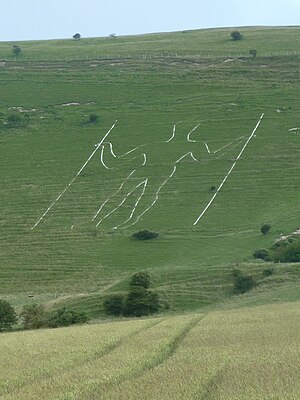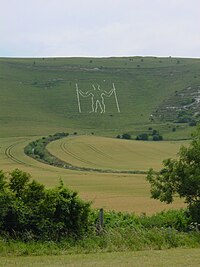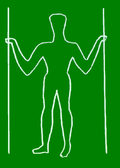Long Man of Wilmington
The Long Man of Wilmington is a hill figure on the steep slopes of Wilmington Hill near Wilmington in Sussex. It is six miles north-west of Eastbourne and a third of a mile south of Wilmington. Locally, the figure was once often called the "Green Man".[1]
The Long Man is 235 feet tall,[2] holds two "staves", and is designed to look in proportion when viewed from below.
The figure was once thought to originate in the Iron Age or even the Neolithic period. A 2003 archaeological investigation has suggested disappointingly that the figure may have been cut in the Early Modern era – the 16th or 17th century AD. From afar the figure appears to have been carved from the underlying chalk; but the modern figure, since Victorian restoration work, is formed from white-painted breeze blocks and lime mortar.
The Long Man is one of two major extant human hill figures in Britain; the other is the Cerne Abbas Giant, north of Dorchester in Dorset. Both are Scheduled Ancient Monuments. Two other hill figures that include human figures are the Osmington White Horse and the Fovant regimental badges. The Long Man is one of two hill figures in Sussex; the other is the Litlington White Horse.
Contents
Location
- Location map: 50°48’36"N, 0°11’17"E
The figure is carved into the steep chalk escarpment of Wilmington Hill, which rises up to the south of Wilmington village, in the South Downs, eastward of the cut through the Downs made by the Cuckmere River. On the same hillside and that of the linked Windover Hill are other ancient remains, if less spectacular; of tumuli and long barrows.
A number of footpaths and walking trails pass over the hill near the Giant: the Wealdway on the ridge of the hill above the Giant, the South Downs Way crossing down the slope beneath the Giant, and a number of local footpaths and bridleways.
Origins
The origin of the Long Man remains unclear. For many years the earliest known record was a drawing made by William Burrell when he visited Wilmington Priory, near Windover (or Wind-door) Hill, in 1766. Burrell's drawing shows a figure holding a rake and a scythe, both shorter than the present staves.[3] In 1993, another drawing was discovered in the Devonshire Collections at Chatsworth House which had been made by the surveyor John Rowley in 1710, now the first definite date on which the figure is known to have existed.[4]
An early suggestion, sometimes stated to be a local tradition, was that the Long Man had been cut by monks from nearby Wilmington Priory, and represented a pilgrim, but this was not widely believed by antiquarians, who felt that monks were unlikely to have created an unclothed figure.[5] Until fairly recently the Long Man was most commonly asserted to have been cut in the Neolithic period, primarily due to the presence of a long barrow nearby, or given an Iron Age attribution based on a perceived similarity to other hill figures.[6]
Professor John North wrote that during the centuries around 3480 BC the figure would have been positioned to mark the constellation Orion's movement across the ridge above it. The figure, according to this interpretation, may have been a manifestation of a Neolithic astral religion.[7] Another suggestion was that the figure had a Romano-British provenance, while an origin in the time of Anglo-Saxon England gained credence after the 1965 discovery at Finglesham in Kent of an Anglo-Saxon brooch depicting a figure, (possibly Woden), holding two spears in a similar fashion to the Long Man.
Archaeological work performed in 2003 by Professor Martin Bell of the University of Reading, in association with Aubrey Manning's Open University programme Landscape Mysteries, strongly suggested that the figure dates from the Early Modern period – the 16th or 17th century AD.[8] Bell found that the slope on which the Long Man was cut had gone through a period of instability in this time, after a very long prior period of stability, suggesting that the figure was first cut then.[6] This has opened up the possibility that the Long Man could be a Tudor or Stuart-era political satire in the manner recently posited for the Cerne Abbas giant, or possibly a religious image associated with the Reformation: Professor Ronald Hutton noted that "we can at least celebrate the fact that we have our first, apparently unequivocally, Early Modern hill figure, and historians now have to reckon with it."[6]
Pre-20th century history
Whatever the figure's origin, for much of its history it seems to have existed only as a shadow or indentation in the grass, visible after a light fall of snow or as a different shade of green in summer: it is described or illustrated as such in 1710, 1781, 1800, 1835 and 1851.[1] Indeed, the figure was once known locally as the "Green Man".[1] Earlier depictions, such as those of Rowley and Burrell, show other details such as a possible scythe blade on the right-hand staff and the suggestion of a helmet or hat on the figure's head: they also indicate a different, albeit indistinct, position for the feet. The current outline of the Long Man is largely the result of a 'restoration' of 1873-4, when a group led by the vicar of Glynde, Reverend William de St Croix, marked out the outline with yellow bricks whitewashed and cemented together, though it has been claimed that the restoration process distorted the position of the feet.[3]
The archaeologist John S. Phené, who was co-opted into the project and whose 1873 talk to the Royal Institute of British Architects had originally inspired it, initially expressed his reservations with both the bricking and the design used.[9] The original intention of the 'restoration' had been to cut the figure down to the chalk bedrock, but had been abandoned after trials showed that the soil depth made this too difficult.[10]
In the years after the 'restoration' several people familiar with the figure commented that the feet were altered, having originally both pointed outwards and downwards so that "the Giant appeared to be coming down the hill", in the words of Ann Downs, who had grown up at Wilmington Priory in the 1840s.[1] Resistivity surveys conducted in the 1990s by R. Castleden, combined with examination of apparent shadow marks shown in early photographs, have provided strong evidence that the feet had in fact pointed outwards as described by 19th century observers and had been slightly lower than in the current outline.[11] The surveys showed that the figure had likely been originally cut by trenching, in the same manner as other chalk hill figures, but had been abandoned after only a few scourings.[12]
There was also some evidence to suggest that the feature on one staff similar to a scythe blade, flail or shepherd's crook was genuine, along with a suggestion of a "helmet" or hat.[13] It seems likely that the proportions of the figure have been distorted slightly by the 1873 bricking and the 1969 replacement of the bricks with breeze blocks, with the Long Man having been up to 248 feet tall before 1873.
20th and 21st centuries
In 1925, the site of the Long Man was given to the Sussex Archaeological Trust (now the Sussex Archaeological Society) by the Duke of Devonshire. During the Second World War it was painted green to avoid it being used as a landmark by German aircraft.
At dawn on May Day, the Long Man Morris Men dance at the foot of the Long Man.[2] The Long Man has also attracted neo-pagans, who hold rituals there.
The figure has become a symbol for Sussex folk as a whole: the giant appears on car stickers and occasional protest literature with the Sussex slogan "We wunt be druv" and variants.
Popular fiction
Eleanor Farjeon, in her book Martin Pippin in the Daisy Field (1937), gives a fancy origin of the giant in a form of a folktale told by Martin Pippin the bard to six young girls in the daisy field.
In his comic The Sandman #19 (1990), Neil Gaiman interprets the figure as the guardian of a gateway into Faerie.
Electronic pop group Kissing the Pink shot the promotional video for their 1982 single "Mr Blunt" at the Long Man.
The Long Man plays a prominent role in the Spike and Suzy comic book "The Circle of Power" (1998).
See also
Outside links
| ("Wikimedia Commons" has material about Long Man of Wilmington) |
- Long Man of Wilmington at the Sussex Archaeological Society
References
- ↑ 1.0 1.1 1.2 1.3 Castleden 2002, p. 85.
- ↑ 2.0 2.1 "Long Man cleaned up for May Day". BBC News. 29 April 2007. http://news.bbc.co.uk/2/hi/uk_news/england/sussex/6591483.stm. Retrieved 26 June 2015.
- ↑ 3.0 3.1 Cope, Julian (1998). The Modern Antiquarian. London: Thorsons. ISBN 0-7225-3599-6.
- ↑ Castleden 2002, pp. 83-95.
- ↑ St Croix, Rev. W. "The Wilmington Giant" in Sussex archaeological collections relating to the history and antiquities of the county, Volume 26, 88
- ↑ 6.0 6.1 6.2 Bell, Martin; Hutton, Ronald (July 2004). "Not so long ago". British Archaeology (Council for British Archaeology) (77). SSN 1357-4442. http://www.britarch.ac.uk/ba/ba77/feat2.shtml.
- ↑ North, John David (1996). Stonehenge: A New Interpretation of Prehistoric Man and the Cosmos. New York: Free Press. ISBN 0-684-84512-1.
- ↑ Derbyshire, David (2 October 2003). "Prehistoric Long Man is '16th century new boy'". Daily Telegraph (London: Telegraph Media Group). https://www.telegraph.co.uk/news/uknews/1443003/Prehistoric-Long-Man-is-16th-century-new-boy.html. Retrieved 8 February 2009.
- ↑ Castleden 2002, p. 86.
- ↑ Castleden 2002, pp. 83-84.
- ↑ Castleden 2002, p. 92.
- ↑ Castleden, Rodney (2012). The Wilmington Giant: The Quest for a Lost Myth. Blatchington Press. p. 36. ISBN 978-1-4717-6887-3. https://books.google.com/books?id=Bf5PDwAAQBAJ.
- ↑ Castleden 2002, p. 93.
- Castleden, Rodney (2002). "Shape-shifting: The changing outline of the Long Man of Wilmington". Sussex Archaeological Collections (140). http://ads.ahds.ac.uk/catalogue/adsdata/arch-285-1/dissemination/pdf/vol_140/Castleden.pdf.


